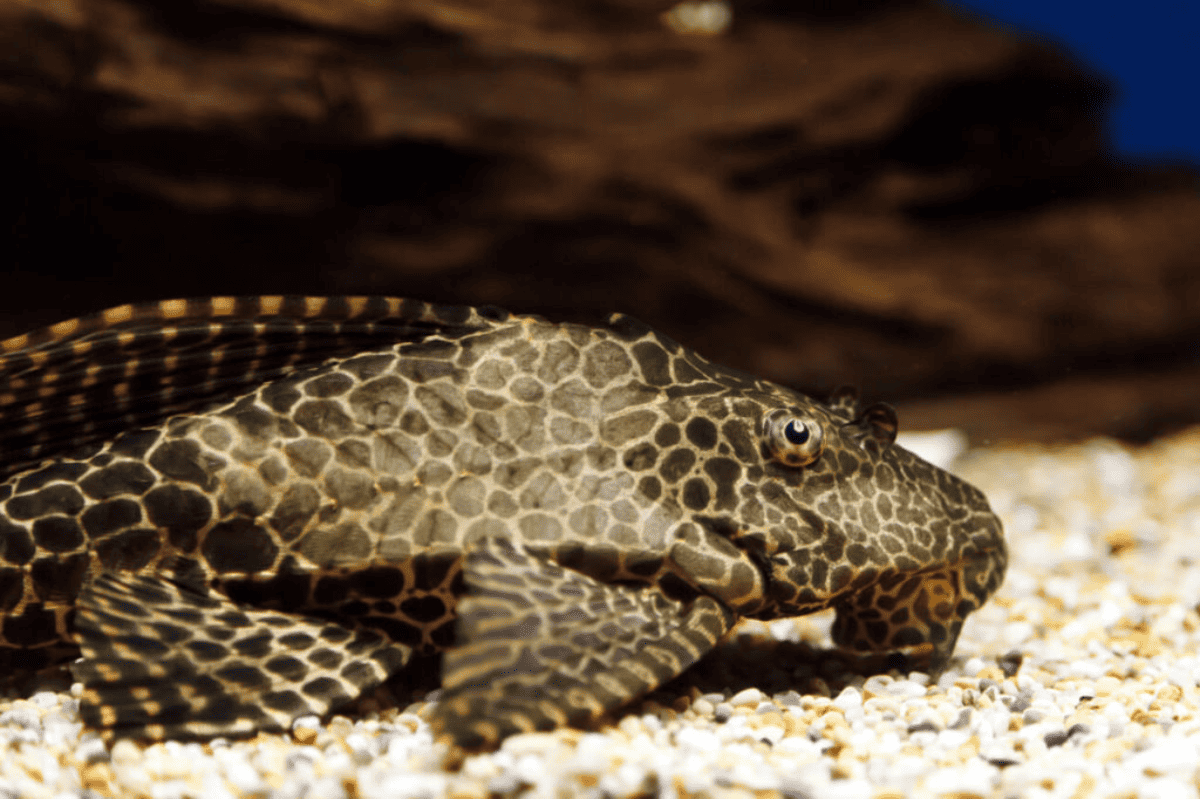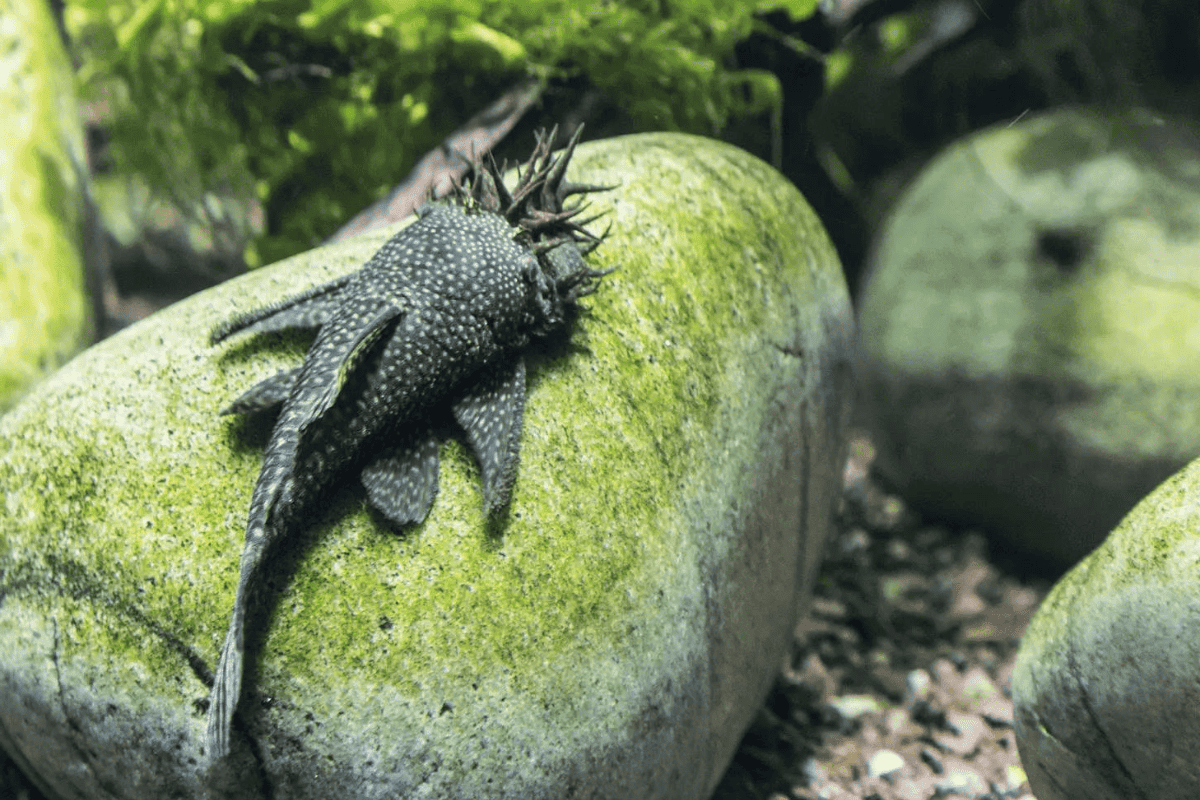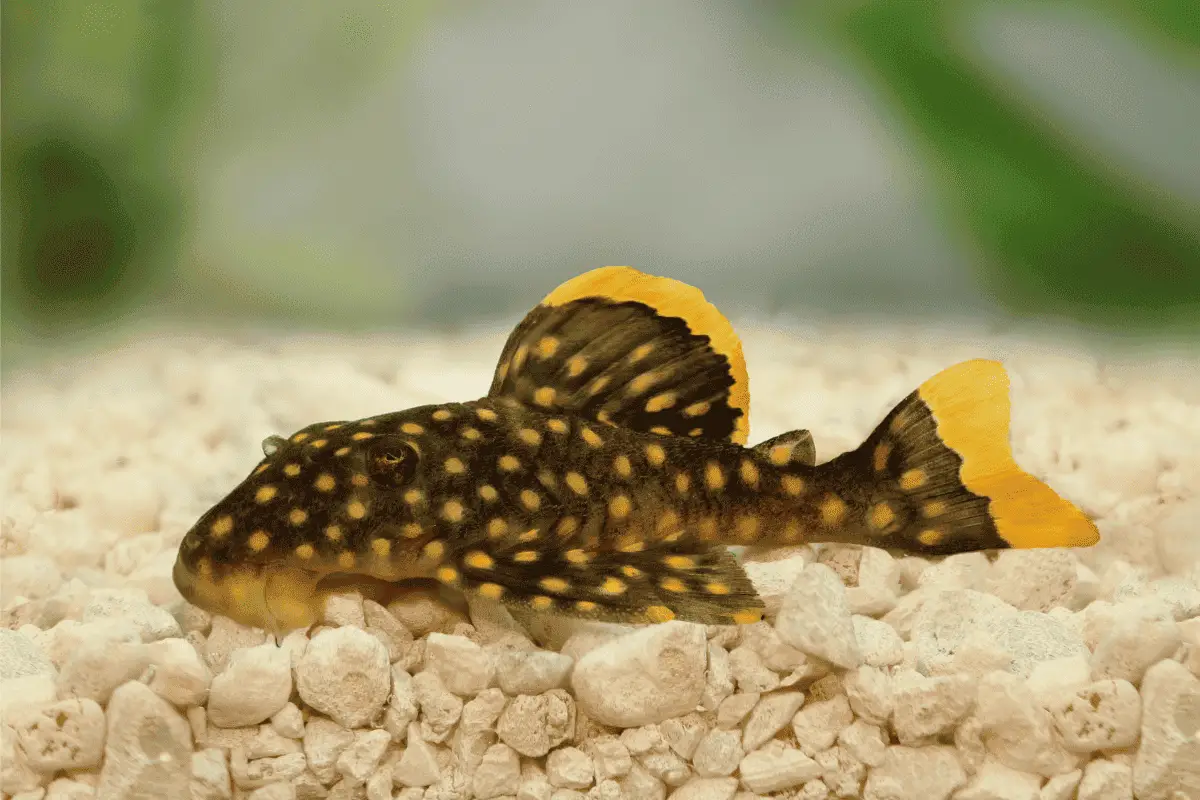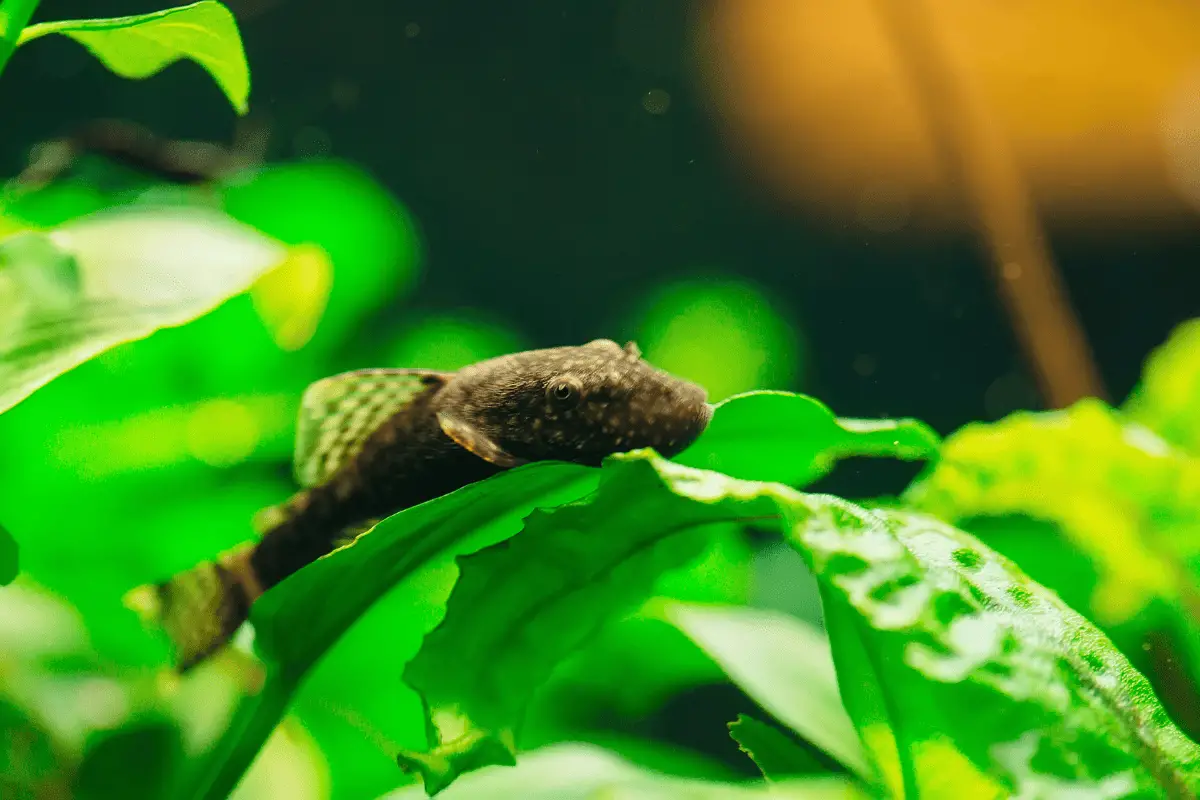Plecos and Angelfish are both favorites for freshwater aquarium enthusiasts. But is it okay for them to share the same space?
What should you think about when housing them together? How does tank design, water conditions, and their dietary needs come into play?
Which Pleco varieties work well with this combo, and which ones might not be a good fit? And what other species can you introduce?
In this article, I’ll discuss all these questions and more, so you leave with everything you need. Let’s get started.

Can Plecos and Angelfish Share the Same Tank?
Yes, Plecos and Angelfish can share the same tank under the right conditions. Both species, when cared for properly, can coexist harmoniously.
- Dietary Overlaps: Plecos, primarily bottom feeders, feed on algae and detritus. Angelfish eat insects and crustaceans, reducing food competition.
- Differing Zones: Plecos stay at the tank’s bottom, while Angelfish prefer middle to top layers, minimizing territorial clashes.
- Temperament Compatibility: Plecos are generally peaceful and focus on scavenging. Angelfish are also non-aggressive unless breeding.
- Temperature Needs: Both species thrive in temperatures of 74-82°F, ensuring neither faces thermal stress.
- Tank Size Considerations: Plecos need space, but in a 55-gallon or larger tank, both species have ample room to flourish.
Also Read: Pleco Fish Tank Mates
Plecos vs. Angelfish: Natural Behavior
The first factor worth considering is the Pleco’s and the Angelfish’s natural behavior. Here is what you should know:
Pleco Fish: Natural Behavior
Plecos are nocturnal scavengers native to South America, known for their bottom-dwelling habits.
Their behaviors are shaped by their natural environment and the need to find food while staying safe.
- Hiding Tendencies: Plecos frequently seek refuge during the day in driftwood, caves, or other tank decorations. Such behavior stems from their wild habits of avoiding daytime predators.
- Scavenger Diet: Their diet mainly comprises algae and waste, playing the role of tank cleaners. This natural feeding behavior helps maintain a cleaner aquarium environment.
- Nocturnal Activity: Most of their active behaviors, like feeding and exploration, happen at night. This pattern reduces daytime competition and exposure to threats.
- Territorial Displays: Especially in males, Plecos can be territorial, often defending their chosen hideout. This is crucial in the wild to ensure safe refuge and access to food.

Angelfish: Natural Behavior
Angelfish, native to the Amazon Basin, are popular freshwater fish known for their grace and striking appearance.
They swim mid-water and display behaviors befitting their semi-aggressive nature.
- Vertical Swimming: Angelfish possess a unique body shape allowing vertical navigation. This allows them to efficiently move between plant leaves and other obstacles.
- Carnivorous Diet: While they appreciate some plant matter, Angelfish primarily eat smaller fish and invertebrates. In an aquarium, they might chase smaller tank mates.
- Parental Care: Unlike some fish, Angelfish exhibit strong parental care, guarding their eggs and fry. This behavior showcases their evolved reproductive strategy.
- Territorial Instincts: Angelfish can establish territories, especially during breeding. This ensures the safety of their offspring and access to resources.
Also Read: Angelfish Tank Mates

Ideal Water Parameters for Plecos and Angelfish
When it comes to water conditions, Plecos and Angelfish have some overlaps and distinct preferences. This table will help ensure your tank meets the needs of both.
| Parameters | Plecos | Angelfish | Both Types |
| Temperature | 74°F-80°F | 76°F-82°F | 76°F-80°F |
| pH Level | 6.5-7.5 | 6.8-7.8 | 6.5-7.8 |
| Water Hardness | 6-10 dGH | 5-13 dGH | 6-10 dGH |
Pleco Fish: Ideal Parameters
Plecos prefer slightly warmer waters with a pH that leans towards the neutral side. They are fairly adaptable but thrive best in stable water conditions.
- Temperature: Plecos thrive in temperatures between 74°F and 80°F, ensuring their metabolic processes function optimally.
- pH Level: The ideal pH range for Plecos is between 6.5 and 7.5, providing a balanced aquatic environment.
- Water Hardness: Plecos can adapt to a range of hardness but generally prefer softer to moderately hard water.

Angelfish: Ideal Parameters
Angelfish also prefer warm waters with a neutral to slightly acidic pH. Stability in water conditions is crucial for their well-being.
- Temperature: Angelfish are comfortable in temperatures ranging from 76°F to 82°F, which promotes good health and coloration.
- pH Level: For Angelfish, a pH of 6.0 to 7.5 is ideal, ensuring their bodily functions and well-being are maintained.
- Water Hardness: Soft to moderate water hardness is preferable for Angelfish to ensure proper osmoregulation and health.
Also Read: Can Angelfish And Cory Catfish Live Together?

Plecos vs. Angelfish: Tank Setup
Both Plecos and Angelfish have unique requirements for their habitats. By aligning these needs, one can create an optimal environment for both species.
| Setup Components | Plecos | Angelfish | Both Types |
| Ammonia Nitrite Nitrate | Low | Low | Consistently Low |
| Tank Size | Minimum 30 gallons | Minimum 20 gallons | Minimum 55 gallons |
| Foliage | Some plants | Tall, vertical plants | Variety with tall plants |
| Decorations | Caves & Driftwood | Vertical structures | Caves, Driftwood & Vertical structures |
| Filter | Strong flow | Moderate flow | Moderate to Strong flow |
| Heater | Required | Required | Required |
| Substrate | Sandy or fine gravel | Fine gravel or sand | Mixed fine gravel and sand |
| Pump | Moderate flow | Moderate flow | Moderate flow |
| Lighting | Moderate | Moderate to bright | Moderate |
Pleco Fish: Tank Setup
Plecos require a tank setup that provides ample space due to their potential large size, along with hiding spots and specific water parameters.
The overall environment should simulate their natural habitats to make them feel at home.
- Ammonia Nitrite Nitrate: Plecos need a cycled tank with 0 ppm of ammonia and nitrite. Nitrate levels should be kept under 20 ppm.
- Tank Size: Considering the potential size of some Plecos (up to 24 inches), a minimum tank size of 55 gallons is recommended.
- Foliage: Plecos enjoy tanks with live plants, providing additional grazing surfaces and hiding spots.
- Decorations: Caves and driftwood are essential for Plecos as they offer hiding and resting places.
- Filter: A strong filter is necessary for Plecos, not only for clean water but also to provide flow, replicating river environments.
- Heater: Maintaining temperatures between 74°F and 80°F is critical for Plecos’ well-being.
- Substrate: Sandy or fine-gravel substrate is ideal, allowing Plecos to forage without injuring themselves.
- Pump: A water pump that creates gentle currents can be beneficial, simulating a river-like environment.
- Lighting: Plecos are nocturnal, so subdued lighting or periods of darkness is preferable.

Angelfish: Tank Setup
Angelfish need a tall tank given their tall body shape, combined with good water quality, appropriate decorations, and plant coverage to mimic their natural environments.
- Ammonia Nitrite Nitrate: Angelfish, like Plecos, require 0 ppm of ammonia and nitrite. Nitrates should be under 20 ppm.
- Tank Size: A minimum of 30 gallons is recommended for Angelfish, but larger tanks are ideal, especially for multiples.
- Foliage: Tall plants, like Amazon swords, are preferred, offering cover and territorial boundaries.
- Decorations: Vertical decorations and pieces of driftwood can offer Angelfish territorial markers and hiding spots.
- Filter: Angelfish require a filter strong enough to keep the water clean but not so strong that it creates excessive currents.
- Heater: Temperatures between 76°F and 82°F are optimal for Angelfish.
- Substrate: A fine-gravel substrate is ideal for Angelfish, complementing their natural habitat preferences.
- Pump: Gentle water movement is suitable, so a moderate water pump is recommended.
- Lighting: Moderate lighting helps showcase the Angelfish’s stunning colors and supports plant growth.

The Dietary Requirements of Plecos and Angelfish
Feeding Plecos and Angelfish properly involves understanding their dietary needs. Here’s a concise guide to ensure both species receive adequate nutrition.
| Diet Component | Plecos | Angelfish | Both Types |
| Food Types | Algae wafers, vegetables | High-quality flakes, live foods | Algae wafers, flakes, live foods |
| Quantity | As much as they can eat in 5 minutes | As much as they can eat in 3-5 minutes | Monitor and adjust based on fish numbers |
| Feeding Schedule | Daily | 2-3 times a day | 2-3 times a day with varied diet |
Pleco Fish: Ideal Dietary Requirements
Plecos are omnivorous scavengers that primarily feed on algae but also benefit from a varied diet to ensure they receive all necessary nutrients.
- Food Types: Algae wafers are a staple, but Plecos also appreciate veggies like zucchini and occasional protein in the form of bloodworms or brine shrimp.
- Quantity: Feed Plecos enough that they can consume within 20-30 minutes to prevent overfeeding.
- Feeding Schedule: Evening feeding aligns with Plecos’ nocturnal habits, though they will forage throughout the day.

Angelfish: Ideal Dietary Requirements
Angelfish are omnivorous and thrive on a mix of high-quality flake food, live foods, and occasional vegetables.
- Food Types: High-quality flake or pellet food serves as a base, but supplementing with brine shrimp, bloodworms, or daphnia is beneficial.
- Quantity: Feed Angelfish an amount they can consume within 3-5 minutes to avoid overfeeding and tank pollution.
- Feeding Schedule: Regular feedings, once or twice daily, will keep Angelfish satisfied and healthy.

Pleco Species Most Suitable for a Tank With Angelfish
When keeping Plecos with Angelfish, it’s essential to opt for Pleco species that remain relatively small and are peaceful by nature.
These species should also thrive in similar water conditions as Angelfish.
- Bristlenose Pleco (Ancistrus spp.): A popular choice, the Bristlenose Pleco remains relatively small, reaching about 4-6 inches in adulthood.
- Clown Pleco (Panaqolus maccus): Staying under 4 inches, this attractive, wood-eating Pleco is an excellent option for tanks with Angelfish.
- Rubber Lip Pleco (Chaetostoma formosae): Typically growing to a maximum of 7 inches, this Pleco is non-aggressive and suitable for cohabitation.
- Butterfly Pleco (Peckoltia compta): This species remains under 6 inches and offers an exotic appearance without being territorial.
- Zebra Pleco (Hypancistrus zebra): A beautiful but rare Pleco, the Zebra Pleco stays small (around 3-4 inches) and is quite peaceful.
Also Read: Can Plecos And Discus Fish Live Together?

Which Pleco Types Shouldn’t Be Kept with Angelfish?
While many Plecos are suitable for Angelfish tanks, some grow too large or exhibit behaviors that may not be compatible with Angelfish’s needs.
- Common Pleco (Hypostomus plecostomus): Growing up to 24 inches, the Common Pleco can become too large and aggressive for Angelfish.
- Sailfin Pleco (Pterygoplichthys gibbiceps): This species can reach up to 18 inches and may dominate the tank, causing stress for Angelfish.
- Royal Pleco (Panaque nigrolineatus): Growing to about 17 inches, the Royal Pleco’s size and territorial behavior might be an issue in shared spaces.
- Vampire Pleco (Leporacanthicus galaxias): Reaching about 10 inches, this Pleco is not only sizeable but may also become territorial.
- Rhino Pleco (Pterygoplichthys scrophus): At a potential size of 11 inches, the Rhino Pleco might claim large territories and disturb the tank’s balance.
How to Introduce Your Pleco to a Tank with Angelfish
When introducing Plecos to an Angelfish tank, careful acclimatization and observation ensure smooth integration.
Preparation and patience can ensure both species thrive together.
- Acclimate Properly: Let the Pleco’s bag float in the tank for 15-20 minutes, then slowly add tank water every 5 minutes for an hour.
- Use a Quarantine Tank: Keep the Pleco isolated for 2-4 weeks in a separate tank, observing for signs of disease or parasites.
- Introduce at Night: Since Plecos are more active at night, release them after sunset to reduce initial stress and confrontations.
- Monitor Closely: Watch interactions for the first 72 hours. If aggression is noted, consider adding barriers or rearranging decor.
- Provide Hiding Spots: Ensure multiple hiding options like caves or driftwood, spaced apart, so the Pleco feels secure and less threatened. My recommendation: Dr. Moss Malaysian Driftwood (link to Amazon).
Also Read: Can Angelfish And Gourami Live Together?

Tips for Keeping Plecos with Angelfish
Creating a harmonious environment for Plecos and Angelfish requires understanding their individual needs and ensuring a balanced ecosystem.
- Space is Key: A minimum of 55 gallons is essential; this provides room for territories and reduces competition.
- Diverse Diet: Offer Plecos algae wafers and Angelfish high-quality flakes. Supplement with vegetables and occasional live foods.
- Tank Cleanliness: Conduct 20-25% water changes weekly. Clean filters monthly to ensure efficient waste removal.
- Regular Monitoring: Check daily for signs of stress, like faded colors or clamped fins, which may indicate underlying issues.
- Avoid Overfeeding: Feed amounts fish can eat in 5 minutes; excess food can cause territorial disputes and tank pollution.
- Maintain Ideal Parameters: Keep the water at 76°F-82°F, with pH levels between 6.5 and 7.5, ensuring comfort for both species. For accurate measurements, I personally use the API FRESHWATER MASTER TEST (link to Amazon).
- Provide Vertical Structures: Angelfish, with their tall bodies, appreciate tall plants and vertical decor for territorial markers.
Best Tank Mates for Plecos and Angelfish
Both Plecos and Angelfish are relatively peaceful and can cohabit with a variety of other species.
Ensuring harmony in your tank and lessening chances for hostility starts with choosing the right companions.
- Corydoras Catfish: Like Plecos, they enjoy the tank’s bottom. They’re notably smaller and are known for their gentle demeanor, making them a good fit.
- Tetras: Neon and Cardinal Tetras, for instance, are petite, group-loving fish that primarily stick to the mid-water, minimizing overlap with either Plecos or Angelfish.
- Dwarf Gouramis: These guys have a chill vibe, matching well with Angelfish. Plus, they prefer the tank’s top, staying clear of Plecos’ zones.
- Rasboras: Take Harlequin Rasboras; they’re friendly and school together, lowering the odds of clashes with both Plecos and Angelfish.
- Rainbowfish: Their vibrant behavior and liking for mid to top sections of the tank make them excellent pals for both Plecos and Angelfish without territory issues.
- Loaches: Some, like the Kuhli Loach, enjoy the bottom of the tank and are recognized for their peaceable coexistence with Plecos, adding a varied touch to the tank’s bottom areas.
Also Read: Can Plecos And Loaches Live Together?

Conclusions
For those scanning through, here’s a short summary:
- Plecos and Angelfish can happily share a space given ample room and shared water conditions.
- Plecos are night-loving bottom-hangers, and Angelfish prefer the mid to top waters, which means less overlap.
- Both these fishies have particular needs when it comes to water, habitat, and food for thriving.
- When pairing with Angelfish, opt for smaller and calmer Pleco varieties and sidestep the big or feisty ones.
- Introducing Plecos to an Angelfish tank? Ensure proper acclimatization, keep an eye out, and provide hiding spots.
- Keep the peace by offering ample space, diverse foods, tidy habitats, and congenial tank mates.

